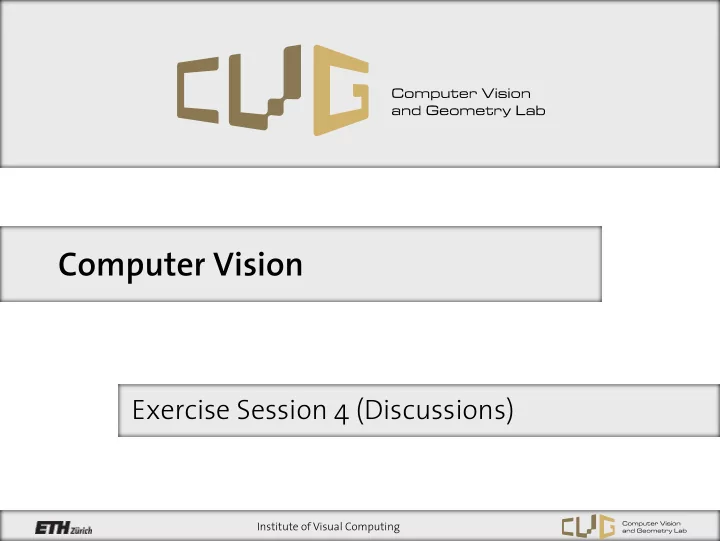

Computer Vision Exercise Session 4 (Discussions) Institute of Visual Computing
SIFT feature extraction You want lot of discriminative features to get matches. It is a bad idea to increase the threshold to be able to plot correspondences. Just plot a subset of the putative matches. Institute of Visual Computing
SIFT feature extraction and scene choice This is a perfect scene : You get a lot of SIFT features, exactly where you expect them to be. Good job Stefan Brugger! Inliers with threshold = 0.1 pix (Sampson) Institute of Visual Computing
RANSAC – the big picture It is meant to find small set of good inliers out of the noise: You better have lots of putative correspondence ! lots of iteration (e.g. 10 000) is fully normal! (it’s quick in c++) The threshold has to be understood together with the distance. 2 pixels for the sum of distances is equal to 1 pixel of average reprojection error but not for Sampson distance. We are filtering correspondences: i.e. We do not mark points as outliers, but correspondences. You always need to re-estimate F/E on all inliers ! Institute of Visual Computing
RANSAC – adaptative This is what we want to to, since we can not set the number of iteration other way, (1000 is really too arbitrary and too low !) Do not stop at 1000 iteration(!!) Institute of Visual Computing
5pt-RANSAC Advantage of taking less samples It helps a lot for small inlier ratios. Institute of Visual Computing
5pt-RANSAC Please make sure to compute the Sampson distance with F and un-normalized points Refine E on inliers using your essentialMatrix from Ex2 (calibrated_fivepoints does not work with more than 5 input, you can check the code of calibrated_fivepoint_helper.c) Institute of Visual Computing
Decompose E It could be that you still have wrong matches in your inlier set. Those could be behind the camera. To select which of the 4 configurations is good, take the one with most matches in front. Institute of Visual Computing
Recommend
More recommend